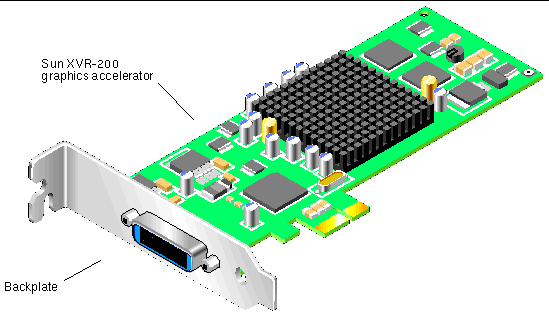| C H A P T E R 1 |
|
Sun XVR-200 Graphics Accelerator Overview |
The Sun XVR-200 graphics accelerator (FIGURE 1-1) is a low-profile single-slot 24-bit PCI-Express graphics frame buffer. The Sun XVR-200 graphics accelerator runs on the Sun Fire T2000 system. This chapter includes the following topics:
The Sun XVR-200 graphics accelerator installation kit includes:
The Sun XVR-200 graphics accelerator (FIGURE 1-1) offers the following advanced features:
See the following sections for details.

FIGURE 1-2 shows the Sun XVR-200 graphics accelerator back panel LFH-60 I/O port.

The Sun XVR-200 graphics accelerator is a low-profile single-slot 32-Mbyte frame buffer keyed for an x1 PCI-Express bus interface. The output connector is an LFH-60 video port that requires the monitor cable adapters provided in the installation kit for DVI and HD15 (VGA) type monitor cabling.
The 8+24 mode simultaneously supports 8- and 24-bit visuals. This mode addresses the classic colormap flashing issue with a 24-bit visual while providing the 8-bit visual that is required by some legacy 8-bit color only applications.
All Sun XVR-200 graphics accelerators support off-screen pixmap caching. Cached pixmaps are those that are stored in the off-screen memory. These off-screen pixmaps allow faster transfer rates to and from on-screen windows.
The available off-screen memory depends on the amount of video memory, the current resolution, and depth settings. For example, the Sun XVR-200 graphics accelerator has 32 Mbytes of video memory.
If the board is running at 1024 × 768 resolution with a depth of 8-bits, 768K is used for on-screen memory. That leaves 31.2 Mbytes available for pixmaps. In 24-bit and 8+24-bit modes, the on-screen memory that is used is four times larger than what is used in the 8-bit mode.
The largest pixmaps are stored in off-screen memory. If a larger pixmap replaces a smaller pixmap in the off-screen memory, the smaller pixmap moves to system memory and remains there even after the larger pixmap is destroyed.
Sun OpenGL for Solaris support is provided through the Direct Pixel Access (DPA) Extension. The Sun OpenGL 1.5 for Solaris software support is provided in the Solaris 10 1/06 Operating System.
Copyright © 2006, Sun Microsystems, Inc. All Rights Reserved.